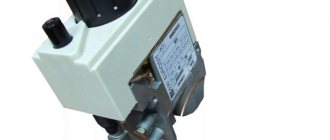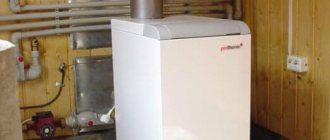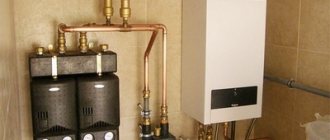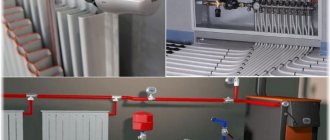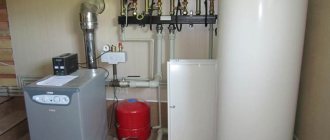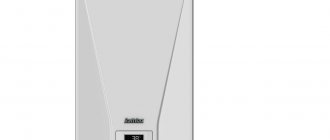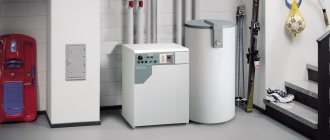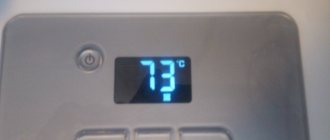How does a coaxial chimney work?
A coaxial pipe is installed to simultaneously remove combustion products and take in fresh air.
Let's take a closer look at how a coaxial chimney works:
- Air is taken in using the external channel. The air flow passes through the pipe, as a result of which it heats up. Heating occurs due to the internal channel through which combustion products escape. Gas consumption is significantly reduced due to the heated air that enters the combustion chamber. Consequently, the efficiency of the gas boiler increases.
Important! A coaxial chimney can be installed in wooden houses without a special degree of fire protection. Since the outer channel of the coaxial chimney reduces the temperature outside the pipe and works as a cooling system.
- Some chimneys are insulated to improve draft quality. The internal channel acts as a drain for burnt products. With this system, three channels are used, one of them is basalt insulation.
- For high-quality operation of a coaxial chimney, you must follow all installation rules and perform the assembly correctly.
Advantages and disadvantages of a coaxial chimney for a gas boiler
The type of smoke exhaust structures under consideration has the following positive qualities:
- Increasing the efficiency of heating equipment . The coaxial chimney provides air flow in the required quantity and properly removes all combustion products, so the heat transfer of the fuel is maximized. In addition, a balanced air mass circulation pattern reduces the amount of harmful substances emitted into the atmosphere by an order of magnitude.
- Fire safety . During operation of the boiler, the outer pipe does not heat up to a temperature that could cause a fire in the surfaces in the immediate vicinity. Even when installing the device through wooden floors, fire safety measures can be significantly mitigated. The occurrence of fire in the chimney itself is also excluded - solid fuel particles do not accumulate on the inside of the chimney.
- Preservation of microclimate . Since air exchange occurs in a closed system, the microclimate of the room is not affected in any way - humidity, temperature and air composition remain unchanged.
- Economical . A coaxial chimney for a gas boiler can significantly reduce the level of heat losses, so as a result the equipment is more economical.
- Small dimensions . Due to their compactness and the possibility of external installation, coaxial chimneys take up very little space from the room, which is especially important if the area of the room where the boiler is installed is already small.
- Easy to install . The presence of ready-made elements significantly simplifies the process of assembling the structure and allows you to select a chimney for specific operating conditions.
- Resistance to aggressive environments . The pipe located inside the chimney can easily withstand the effects of aggressive acids formed during combustion and temperatures up to 500 degrees. If the installation and operation rules are followed, a coaxial chimney for a gas boiler can operate for more than 25 years.
Among the disadvantages, the following qualities can be noted:
- Weak resistance to condensation . If installed incorrectly, condensation can form in the pipe, which can turn into ice at subzero temperatures.
- Electricity dependence . In systems with forced air circulation, the chimney may simply stop working if there is a power outage or low voltage in the network.
- High price . A coaxial chimney is expensive in itself, and repairs will also require a considerable amount.
Classification by the number of equipment serviced
There are chimneys for individual and collective service. The first ones do not have branches and are used only for one boiler.
In a collective chimney, branches from heat generators are connected to a common channel. This type of chimney can only be vertical.
Coaxial chimney installation + installation and installation standards
Warmth in the house is the main component of coziness and comfort. There are many ways to heat your home. And if for multi-apartment buildings this is centralized heating, then the owners of their own houses prefer to install a variety of boilers. Heating devices operating with fire cannot do without a smoke removal device. Traditional pipes are being replaced by new, more advanced equipment. An increasing number of homeowners are deciding to install a coaxial chimney, a more practical and effective device for removing smoke.
What makes the coaxial design unique?
The term “coaxial” implies the presence of two objects inserted into one another. Thus, a coaxial chimney is a double-circuit structure made of pipes of various diameters, located one inside the other. There are jumpers inside the device that prevent the parts from touching. The equipment is installed in heat generators equipped with closed combustion chambers. These include, for example, gas boilers.
The coaxial chimney is designed in such a way that the inner pipe is designed to discharge combustion products into the atmosphere. The outer one, which has a larger diameter, is used to supply fresh air to ensure combustion
Thanks to the special design of a standard coaxial chimney, it performs two functions at once: it creates an uninterrupted supply of air necessary to ensure the combustion process, and removes combustion products outside. The length of the device most often does not exceed two meters. It is mainly intended for horizontal placement and is exposed to the street through the wall. Less often you can find a structure that extends through the ceiling and roof.
The special design of a coaxial chimney allows it to function according to a completely different principle from a conventional device. The oxygen required for combustion enters the boiler from outside. Thus, there is no need to ensure a constant flow of fresh air into the room through ventilation, which is inevitable for traditional smoke exhaust ducts. In addition, a number of problems typical of standard chimneys are successfully solved:
- Reduction of heat losses by heating the air coming from outside from the internal hot smoke exhaust pipe, which results in higher system efficiency.
- Reducing the risk of fire in areas of contact between flammable surfaces and the smoke exhaust duct, since the internal pipe, transferring heat to the external one, is cooled to safe temperatures.
- The high efficiency of the system allows for complete combustion of fuel, so unburned particles are not emitted into the atmosphere and do not pollute it. A boiler equipped with a coaxial chimney is environmentally friendly.
- The combustion process, including the supply of oxygen and the removal of gases, takes place in a closed chamber. This is safer for people, since hazardous combustion products do not enter the room. Therefore, additional ventilation is not required.
- Save space due to the compact size of the device.
- A wide range of chimneys designed for systems of varying power.
Features of installation of such a chimney system
There are two main types of arrangement of coaxial chimneys: horizontal and vertical. The direction of the smoke exhaust duct is determined individually for each boiler. It must be taken into account that horizontal devices are installed only if a heating device with forced ventilation is used. Moreover, according to SNiPs, the maximum length of the horizontal section of a coaxial chimney should not exceed 3 m. However, some manufacturers set other restrictions for their products. Therefore, before designing a structure, you should carefully read the characteristics of the device.
When properly designing and subsequently installing a standard coaxial chimney, you must take into account the dimensional parameters indicated in the diagram
Vertical ones are used if, for a number of reasons, it is impossible to arrange a channel outlet for smoke removal directly through the wall: closely spaced windows, small street width, etc. Installation of a coaxial chimney can also be done obliquely. We begin installation of the system with the correct selection of the device.
According to the installation standards for an internal coaxial chimney, the diameter of the boiler outlet should not be larger than the diameter of the outlet channel. We make sure to control this point by checking the chimney passport, which indicates its diameter. Connection to the boiler is made using an elbow, tee or pipe. In this case, each subsequent element is attached to the previous one so that no obstacles are created for the removal of combustion products.
The list of elements required for installation depends on whether the outlet pipe is located on the side or at the top. In the second case, the chimney will be easier to remove. For the first option, horizontal assembly of device parts is used. The structure is brought into a vertical position using brackets of various modifications. For installation of coaxial pipes, a special adapter unit is used. In this case, the clamps rigidly secure the junction area with other elements. The use of homemade adapters and extension by winding tape and applying sealant is unacceptable, since this is a very unreliable and unsafe option.
The outlet pipe can be located either on the side or on top of the heating device. In the first case, the mandatory presence of a horizontal section is assumed
When installing a coaxial chimney, remember that the outlet pipe must be at least 1.5 m above the heating device. The pipe outlet is arranged at an angle of at least 3°, this ensures unhindered drainage of condensate. In addition, the outlet of the coaxial chimney is best located at a height of at least 1-1.5 m above the surface, otherwise it may become clogged. If a complex system is being installed, its total length should be about 3 meters.
Requirements! The simultaneous presence of more than two elbows in the design is undesirable. There should be a distance of about 60 cm from the outlet pipe to the nearest windows, and at least half the diameter of the outer chimney pipe to the gas supply pipes.
The fragments of the structure must fit very tightly and fit into each other at a distance of at least half the diameter of the channel cross-section. To guide the chimney around the obstacle, we use special bends with different angles of inclination. It is possible to use two elements at once.
The most critical area of work is the roof. Here it is necessary to carry out work to ensure maximum fire safety of the structure. To do this, we use special insulating pipes, attach non-flammable insulation and be sure to leave an air gap between the ceiling and the pipe. Based on the requirements for the installation of coaxial chimneys, special protective covers are used to avoid possible contact of the smoke exhaust duct with various objects. If the chimney is brought out through the roof, then we carefully seal the exit and cover it with a special apron, which should cover the joint well. If through the wall - any non-combustible materials. A coaxial chimney is always cold - this is one of its distinctive features.
Sometimes homeowners complain about icing on the chimney when installed horizontally. In this case, it is necessary to use special protection:
You should know that each heating device must have its own chimney installed; “combining” is unacceptable.
The coaxial chimney must be equipped individually for each heating device. However, with proper design, a “cascade” connection option is possible
A coaxial chimney is an active design that improves the fire-fighting and environmental characteristics of heating boilers, as well as increasing their operating efficiency. You can install the device yourself, however, if you have doubts about your own abilities, it is better to entrust this very important work to professionals. After all, as practice shows, the work of installing chimneys requires skills and compliance with safety regulations, and competent installation of revisions or condensate drains without the help of specialists is almost impossible.
aqua-rmnt.com
Requirements for the chimney device
Regulatory documents specify the required distances from the chimney to window and door openings, as well as for neighboring buildings and structures. Let's take a closer look at some of the requirements:
- A coaxial chimney can only be installed after approval from the gas service. You can install both horizontal and vertical types of chimney. It is prohibited to connect boilers with natural and forced circulation systems to the same network.
- The chimney head must be placed at a distance of at least two meters from the ground. For a brick wall, the diameter of the hole should be 1 cm larger than the diameter of the pipe, and for a wooden wall, 5 cm larger.
- Before the start and after the end of the heating season, the coaxial chimney is inspected. The accumulated condensate is removed, the joints and the presence of burnout are checked.
- The chimney must protrude from the wall at a distance of more than 0.3 m.
- For wooden houses, all safety requirements must be observed. The distance of the hole should exceed the pipe by 5 cm. A special basalt insulation must be laid in the gap, which will not allow the wood to heat up.
- The chimney must be located at a distance of at least 1.5 meters from adjacent window and door openings. There should be no poles or trees within this distance.
- A coaxial chimney is allowed to be used in multi-storey buildings. In order not to be poisoned by combustion products, you should use a condensing boiler. The chimney must be at a distance of more than 50 cm from the windows, which are located on the same level. And the distance to the window opening, which is located above the pipe, should be more than 1 meter.
Maximum length of coaxial and separate chimneys.
The chimney is one of the most important parts of the boiler, on which its correct operation depends. Incorrect selection of parameters and/or installation of the chimney can lead to damage to an expensive wall-mounted or floor-standing gas boiler. Chimneys for boilers (here we will talk about wall-mounted boilers) come in two main types:
Coaxial chimneys.
Such chimneys are the most popular for wall-mounted boilers. They combine 2 pipes - one for removing exhaust gases, and the other for supplying air to the boiler. It is possible to use such a “pipe” only if the boiler has a closed combustion chamber. Their length is limited to four or five meters. If the length is longer, the boiler will not have enough air and will shut down or not operate optimally.
Various ways to install a coaxial chimney.
I took these recommendations from the passport of the Baxi Eco Four boiler. All other boilers may have their own nuances and before installation you must read the instructions. All possible installation options are shown in the figure below.
All possible installation options
The figure shows that there are 3 different options for coaxial chimneys:
- Diversion through the wall (the simplest option)
- Output to the central chimney type LAS
- Vertical chimney with outlet through the roof
The rest of the drawings are for separate chimneys, and we’ll talk about them a little later.
During installation, it must be taken into account that various bends (most often at 90° and 45°) reduce the possible length of the coaxial smoke exhaust system. This is due to the fact that they create additional resistance to exhaust gases:
- A 90° bend shortens the chimney by 0.5 meters.
- A 45° bend shortens the chimney by 0.25 meters.
The first outlet, which is located at the outlet of the boiler, is not taken into account. For a better understanding, let's use the picture again:
Length of various coaxial chimney options
It is clear from the figure that if you need maximum length, then the number of corners must be reduced to a minimum. Now let’s look at the LAS system, everything is absolutely the same:
LAS chimney system
Such a system is quite exotic, but has every right to exist. I think it will be especially convenient for apartment buildings heated with natural gas.
Now let's look at a vertical chimney for a gas boiler. Let's look at the picture again:
Vertical coaxial chimney for a gas boiler
The figure does not show a condensate collection device, which must be installed. Otherwise, the burner will be flooded with condensate and the boiler will turn off.
Separate chimneys.
Separate chimneys are used if it is necessary to increase the length of the chimney. For some boilers, the length of separate chimneys can reach 30 meters. The maximum length and diameter of split flues may vary depending on the manufacturer. If the boiler was originally designed to install a coaxial chimney, then to switch to a separate chimney it is necessary to install a special separator. At the end, the pipes can be connected again using a gadget called a terminal. This gadget will reduce the maximum possible length.
Separator for coaxial chimney
Various ways to install a separate chimney.
For corners in a separate smoke exhaust system, the same rule remains as for a coaxial one:
- A 90° bend shortens the chimney by 0.5 meters.
- A 45° bend shortens the chimney by 0.25 meters.
- The first 90° bend is not taken into account.
In addition, the intake and exhaust pipes should not be on opposite sides of the building, and the total length of the supply pipe should not exceed 10 meters.
Next, look at the pictures:
Split chimney length Vertical split chimney
Removing condensate from the chimney.
When the boiler is operating, condensation in the chimney is inevitable. This condensate must be removed from the chimney; to do this, you can do the following:
- Install a condensate collector. In this case, the slope of the chimney pipes should be made towards the collector in a ratio of 1 cm per 1 meter of pipe
- Without installing a condensate collector. In this case, the pipes are sloped away from the boiler so that the condensate flows out of the chimney under the influence of gravity. The slope of the pipes must be at least 1 cm per 1 meter.
- For condensing gas boilers, it is necessary to provide a special drainage of condensate to the sewer or a special container. 1 kW of power of such a boiler produces 1 liter of condensate per day.
Summary of the article.
The simplest and cheapest chimney is the coaxial one, but its length is limited to 5 meters. And if you need a longer length, then you should consider using a separate smoke exhaust system. We also must not forget about the collection and removal of condensate from the chimney. We’ll stop here for now, if you have any questions, write them in the comments.
znayteplo.ru
Installation rules
There are several rules that must be followed when installing a coaxial chimney:
When purchasing a gas boiler, there must be instructions for installing a coaxial chimney. Before starting installation, you should carefully study all the rules and requirements.
For economical and safe heating in their home, many people choose a coaxial chimney. Thanks to it, you will create a comfortable atmosphere indoors and protect your home from fire.
You can buy a 24 kW gas boiler in our store.
Basic installation options
Factory chimneys are supplied with detailed installation instructions. Effective operation of double-circuit pipes is ensured only if all specified recommendations are fully observed.
Horizontal installation
This installation option is carried out taking into account the characteristics of a private home. First, you always select a place where the smoke exhaust system will go outside. It is taken into account that the height of the pipe will be at least 1000 mm if the gas boiler is mounted on the floor. This value is measured from the unit's nozzle to the street opening in the wall.
Important! The pipe must not go directly to the street. When a wall-mounted boiler is mounted, then the distance from its nozzle to the hole in the wall can be reduced to 500 mm. In this case, the maximum number of rotary bends should be 2 pieces.
Conventional diagram of horizontal installation Source legkovmeste.ru
When horizontal installation of a coaxial chimney is carried out, never forget about the maximum length of the pipe. This standard depends on the model of the boiler unit and is from 3000 to 5000 m.
If it is necessary to lengthen the channel, couplings are used. They must have heat-resistant rubber seals. During installation, it is prohibited to use any sealants or sealing materials based on silicone.
Vertical installation
When a vertical coaxial chimney is connected, its maximum length can be 7000 mm. This value allows the use of double-circuit pipes in two-story buildings.
When a building is built from aerated concrete blocks, the system is laid inside the building. The reason for this is the inability of such walls to withstand heavy loads. For brick houses, the location of the smoke exhaust does not matter. However, it is always additionally insulated.

